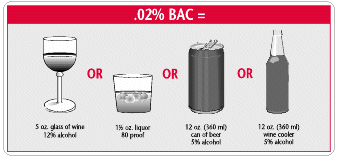

It's important to remember that your BAC can continue to rise even after you've stopped drinking. Hence, it is recommended to use a personal breathalyser to check your BAC before you decide to drive. If we've had a lot to drink the night before, it is very possible that our BAC level the next day is still over the legal limit. While we know better than to drink and drive, many of us forget that alcohol can remain in our system until the morning after. However, one stays the same - drink driving is not tolerated at all and heavy penalties apply for anyone who is caught. The alcohol laws in Australia are different depending on the state or territory you’re in. In other words, one is in violation of the law if they have 50 milligrams or more of alcohol content for every 100 ml of blood while behind the wheel. In Australia, this is the legal limit of alcohol percentage in the bloodstream when operating a motor vehicle.
#BAC STANDS FOR DRIVER#
The single most important number for any driver is 0.05. Best of all, results can be obtained immediately after the test. Unlike blood tests, an alcohol breath test can be done instantly and painlessly. Ultimately, the most practical form of BAC testing is alcohol breath testing using a breathalyser. While they are more convenient than a blood test, they still require technicians or nurse practitioners, and a drug testing kit or lab to test for the results. Urine tests come in at a close second for accurately measuring BAC. A blood test provides the best results but is the least appealing to consumers because it is unpleasant and entails an inevitable wait time for lab results.
#BAC STANDS FOR PROFESSIONAL#
While the gold standard is blood testing it requires a trained professional to perform the intravenous extraction. Three tests are among the industry standard of measuring blood alcohol content. Nonetheless, it will sometimes suffice in legal proceedings, provided the results are jarringly above the legal limit. While an alcohol breath tester can provide substantial enough evidence to arrest a driver, it is still not the official means of determining BAC. Common examples include touching one’s nose whilst walking in a straight line. This explains the implementation of universal impairment tests by law enforcement. In retrospect, impairment cannot be quantified to the same degree as BAC.

Furthermore, the rate of consumption and total time committed to drinking have a profound effect when it comes to determining impairment. However, it also includes food consumption during the period of time when the individual was drinking. The degree of impairment depends on the individual’s age, weight, gender and metabolism. It’s imperative to understand that BAC absorption and metabolic tolerance are mutually exclusive. When one takes this into account, it should be no surprise that BAC content stabilises and can be accurately measured at around 15 minutes after any alcohol intake. It is absorbed through the intestinal and then the vascular walls within seconds. After all, alcohol reaches the bloodstream very quickly. A good indicator of the frequency at which blood is re-oxygenated is our breathing rate. We tend to forget how quickly blood travels through the bloodstream. Everyone’s absorption rate is roughly the same. The reason why one becomes “tipsy” relatively quickly is due to how the human body absorbs alcohol. Put simply, the higher the BAC number, the greater the impairment. Standardised BAC tests enable law enforcement and medical professionals – as well as concerned individuals – to objectively estimate the level of a person’s alcohol intoxication. One major example is developing strategies to treat and prevent alcohol abuse. However, many people overlook its importance for doctors and health practitioners to properly assess their patients. It is the key variable that determines whether law enforcement can legally arrest a driver for impairment. What is BACīAC stands for Blood Alcohol Content and is the industry terminology describing the percentage of alcohol present in an individual’s bloodstream at a particular point in time. We explain some important information about BAC below. However, not everyone understands its meaning or impact on the human body.

Anyone who drinks alcohol should know what is BAC.


 0 kommentar(er)
0 kommentar(er)
